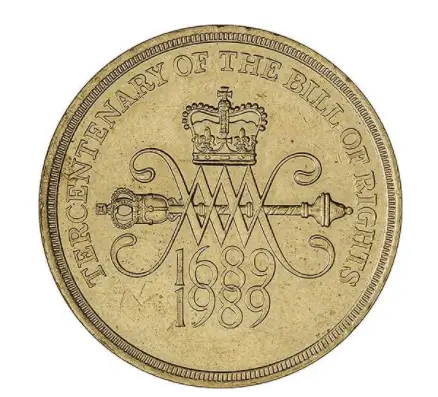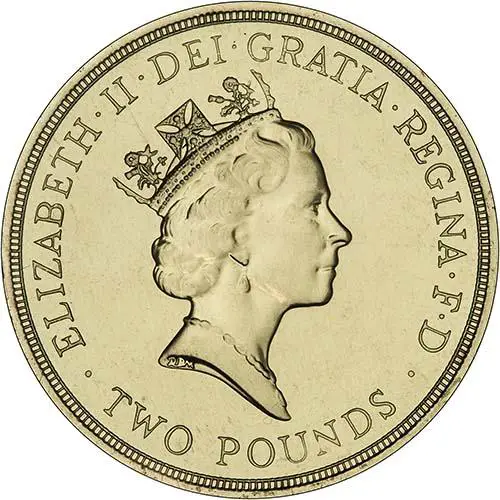If you’ve come across an old single-colour £2 coin you may be wondering if it can be used – but can you still spend old £2 coins, or is there more to the story?
You can spend old £2 coins. However, any shop or bank where you want to spend your old £2 coins has the right to refuse the coins and most likely will. It’s also worth considering that the value of the coin to collectors is larger than the face value of the coin.
This may sound confusing at first, but once you understand the finer details surrounding legal tender and how it is applied in real-life situations.
What Are ‘Old’ £2 Coins?

The £2 that we know today is unique in the fact that it was not released into circulation until 1999, around 26 years after decimalisation.
This is similar to the £1 coin, which interestingly was not released into circulation until 1983, however, the £2 coin remains the ‘newest’ coin in circulation to this day.
Before the introduction of the new £2 coin, commemorative £2 coins were minted between 1986 and 1996 which were single-colour, however, they were intended for collectors and not for general circulation. These coins are what some people refer to as ‘old’ £2 coins, and you can find a list of these old £2 coins below.
- 1986 XIII Commonwealth Games Scotland £2 coin
- 1989 Tercentenary of the Bill of Rights £2 coin
- 1989 Tercentenary of the Claim of Rights £2 coin
- 1994 Tercentenary of the Establishment of the Bank of England £2 coin
- 1995 50th Anniversary of the End of the Second World War £2 coin
- 1995 50th Anniversary of the Founding of the United Nations £2 coin
- 1996 10th European Football Championship £2 coin
Are Old £2 Coins Legal Tender?
Old £2 coins, specifically the single-colour commemorative versions, are legal tender.
The term ‘legal tender’ is quite a specific term that refers to coins or banknotes that must be accepted if offered in payment of a debt. Essentially, if you offered to pay with the old-style £2 coins at a shop the shop owner can’t sue you for failing to repay the ‘debt’.
This legal term has essentially no use in real life, however. A shop owner can still refuse to accept payment in the form of old £2 coins especially as they are more difficult to use in day-to-day life.
A fun fact is that £2 coins are legal tender for any amount, meaning you could pay for a car or even a house using entirely £2 coins legally.
Do Banks Still Take Old £2 Coins?
Unlike bank notes that have gone out of circulation, banks are not obliged to accept any coins that have gone out of circulation, or in this case, never entered circulation.
There are some popular banks such as Halifax and Lloyds that are known for accepting older coins even though they are not obliged to do so. The Royal Mint has even released a statement stating that you will have to try your luck with a high street bank to see if they will accept your old coins.
You can read our in-depth article about what to do with old banknotes and coins here.
Are They Rare?
The pre-1997 £2 coins were very collectable during the time they were minted as they were not only a new coin but each one was commemorative of a particular event or anniversary, which made them very sought after.
The mintages of each coin are listed below, as well as the average selling prices on eBay to give an understanding of how sought-after these coins are.
| Coin | Mintage | Average Sold Value on eBay in 2022 |
| 1989 Tercentenary of the Claim of Rights | 381,400 | £26.91 |
| 1994 Tercentenary of the Establishment of the Bank of England | 1,443,116 | £5.85 |
| 1995 50th Anniversary of the Founding of the United Nations | 1,668,575 | £11.38 |
| 1989 Tercentenary of the Bill of Rights | 4,392,825 | £3.11 |
| 1995 50th Anniversary of the End of the Second World War | 4,394,566 | £3.40 |
| 1996 European Football | 5,141,350 | £5-£7 |
| 1986 XIII Commonwealth Games Scotland | 8,212,184 | £2.30 |
The values above were based on average selling prices on eBay for each coin in circulated condition, and as such the prices can vary. This is especially true when you consider different finishes of the coins, such as proof or silver proof.
Claim of Rights vs Bill of Rights £2 coin
There are two versions of the 1989 £2 coin, which can create quite a bit of confusion amongst coin collectors especially as there is limited information online.
The Bill of Rights £2 coin has the larger mintage, and the inscription says ‘TERCENTENARY OF THE BILL OF RIGHTS’. This coin was minted to commemorate the passing of the Bill of Rights in 1689.
The Claim of Rights is the Scottish version of the coin, bearing the inscription ‘TERCENTENARY OF THE CLAIM OF RIGHTS’ with the Crown of Scotland instead of the St Edward’s Crown featured on the Bill of Rights £2 coin. This version has a much smaller mintage as shown in the table and is therefore rarer.
As the Claim of Rights was also passed in 1689 it bears the same year, which is what has led to confusion amongst some collectors. If you use the table above as a reference you will have no issue collecting any of the pre-1997 £2 coins.
Should You Spend Them?
The obvious answer would be no.
Not only will you struggle to find a shop or bank that is willing to accept the coins, but you will also be losing more than the face value of the coin if you decide to spend it somewhere. The values in the table above give a great indication of how much you could potentially sell one of them on eBay.
Even if you’re not bothered about making a profit these coins are great to keep a hold of or give as a gift to grandchildren or other family members – there really is no good reason to spend one in a shop unless you absolutely have to.
When Did The New £2 Coin Come Out?
1997 marked the introduction of the £2 coin that we know and love to this day, with £2 coins dated from this year introduced into circulation in 1998.
The first reverse design of the new £2 was the technology design shown below which was released every year dating from 1997 right until 2015, to be replaced by the new Britannia design in 2015. Several commemorative reverse designs have also been issued through the years, including the Shakespeare £2 coins, as well as the Trevithick £2 and many others.
The demand for a £2 coin to enter circulation was first recognised in 1994 following a review of the coinage of the United Kingdom. It was decided to use a bimetallic design to easily distinguish the coin from the other coins already in circulation, as well as make £2 the largest by diameter and heaviest by weight of all coins in circulation.
In the first year of launch, there were actually two different versions of the £2 coin released; one featuring Ian Rank Broadley’s portrait of the Queen dated 1998 and the other with Raphael Maklouf’s portrait of the Queen dated 1997.
This is because the 1997 versions were delayed from entering circulation in 1997 due to concerns from the vending industry, which led to both of the coins being released in 1998.
FAQs
There is no end to frequently asked questions about old (and new) £2 coins, so we’ve included some of the most popular ones below.
Are £2 Coins Going Out Of Circulation?
£2 coins won’t be going out of circulation anytime soon, but the Royal Mint does have plans to reduce, or completely shut down, the production of £2 coins for the foreseeable future.
When coins are removed from circulation it is usually either due to a change in a currency such as decimalisation or after a review of the current coinage. Since £2 coins are the largest denomination, they are still used commonly in day-to-day life.
We would expect a smaller denomination of coins such as the one of two pence coins to be removed before the £2 coin is even considered, but you never know!
What Do I Do With Old £2 Coins?
If you have an older £2 coin, you should avoid spending it in a shop and instead hold onto it.
Due to the value of the coins to collectors, it makes more sense to either add the coin to your collection or to sell it to a collector – the choice is yours.
There are only so many of the coins, so if you come across one you should be delighted.

